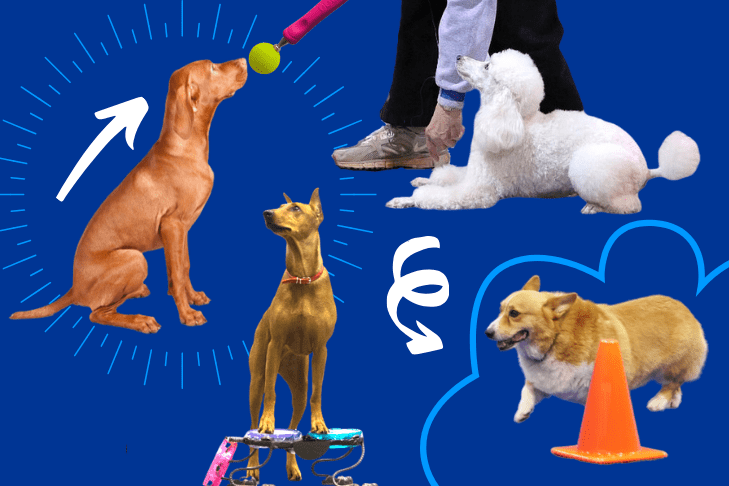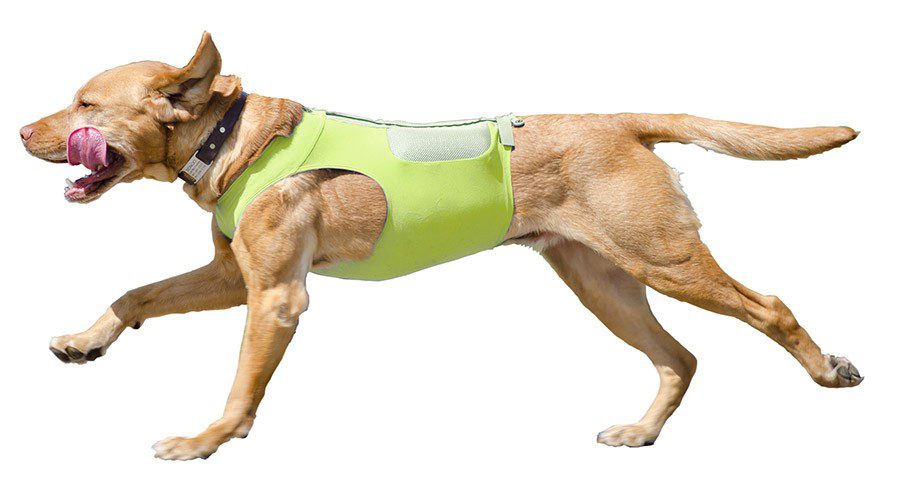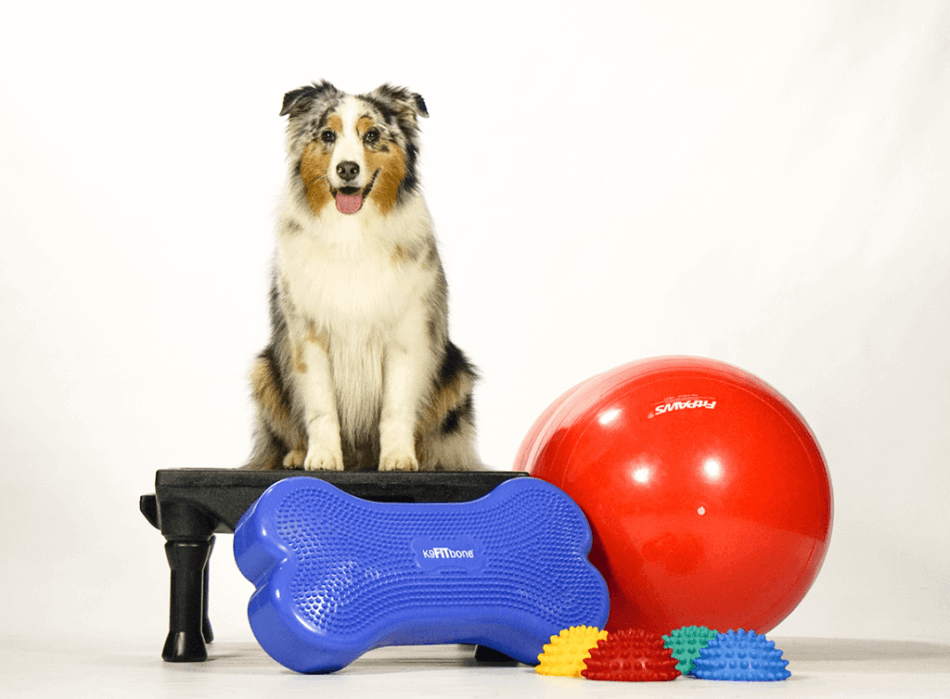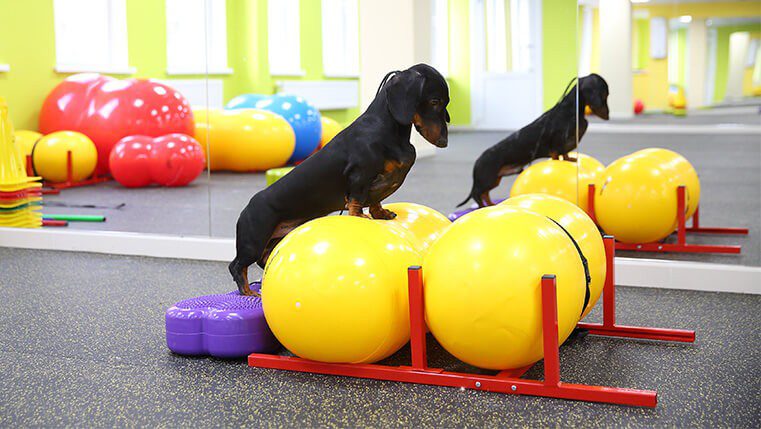
Basic fitness for show dogs: how to do it right?
«
Many owners of show dogs are interested in the question: how to do basic fitness for show dogs? After all, good physical shape is one of the important components of victories in the ring.

Contents
Basic Principles of Basic Fitness for Show Dogs
- Slow pace. This tires the dog more, but it allows you to develop the endurance necessary for the ring, because nothing expressive happens there. All exercises are performed slowly, monotonously.
- Concentration. It is necessary to maintain the proper level of concentration at all times. You can, for example, use treats.
- Execution accuracy. For example, if we do a pull-up, but the dog’s hind legs are X-shaped, nothing good will come of it. Spread the hocks with at least a hand – this way you will include muscles that are not involved in ordinary life, and strengthen the necessary ligaments. Strive for the maximum approximation of the appearance of the dog to the ideal picture.
- Regularity.
- Access to water. The dog must be able to drink as much as he wants, otherwise he will not work with the desired return.
- Fresh air. The lack of oxygen will negatively affect the productivity of classes.
{banner_rastyajka-1} {banner_rastyajka-mob-1}
3 types of basic fitness for show dogs
1. On stable surfaces (anything that doesn’t wobble). It’s very hard for a dog to stay still, so if you’re successful on stable surfaces, that’s great, but you need to move on and include other machines. Exercises can be:
- Single-level: static with handling elements (for example, an exhibition stand on a flat surface for a sufficiently long time).
- Multilevel: active muscle contraction, coordination load.
{banner_rastyajka-2} {banner_rastyajka-mob-2}
2. On special unstable simulators (everything that staggers). Exercises can be:
- Single-level (statics with handling elements, coordination load). The height of the simulator should not be higher than the carpal joint of the dog. It can be a pillow from a sofa, a mattress, etc.
- Multi-level (active study of deep muscles).
- Multiaxial (strengthening of small muscles, articular-ligamentous apparatus).
3. On mixed simulators (a combination of both). Exercises are divided into:
- Single-level (statics with handling elements).
- Multi-level (active study of all muscle groups, strengthening of the articular-ligamentous apparatus).
 It is important to include “switching” loads in your workout! You can’t do several exercises aimed at one part of the body in a row. There are exercises aimed at working out the muscles and the articular-ligamentous apparatus, and there are exercises that work out the exhibition trot itself (basically, these are cavaletti – bars that are at a certain height and distance from each other, at least 4 bars and a maximum of 20 – 5 times 4). “Switching” loads are needed after every 3 exercises. Those. worked on the chest, back, neck – “switched” to working out the lynx. They also worked – they “switched” it again. As slats for cavaletti, you can use gymnastic sticks, or you can use improvised material (for example, sticks from brooms or mops – whatever you find at home). You can lay them out on books to create the desired height. The main thing is that they should not be traumatic, i.e. so that the dog can easily knock them down with his paw in case of a mistake and at the same time do not hurt himself. If the bars are static, bruising or other injury is more likely. The distance between the bars for a comfortable trot is equal to the distance from the glenohumeral joint to the hip joint of your dog. For example, you ran 4 bars of cavaletti, turned around and ran them in the opposite direction – this is how the dog learns to “carry” itself on turns. It is possible to offer rotations around its axis both on a stable surface and on an unstable simulator.
It is important to include “switching” loads in your workout! You can’t do several exercises aimed at one part of the body in a row. There are exercises aimed at working out the muscles and the articular-ligamentous apparatus, and there are exercises that work out the exhibition trot itself (basically, these are cavaletti – bars that are at a certain height and distance from each other, at least 4 bars and a maximum of 20 – 5 times 4). “Switching” loads are needed after every 3 exercises. Those. worked on the chest, back, neck – “switched” to working out the lynx. They also worked – they “switched” it again. As slats for cavaletti, you can use gymnastic sticks, or you can use improvised material (for example, sticks from brooms or mops – whatever you find at home). You can lay them out on books to create the desired height. The main thing is that they should not be traumatic, i.e. so that the dog can easily knock them down with his paw in case of a mistake and at the same time do not hurt himself. If the bars are static, bruising or other injury is more likely. The distance between the bars for a comfortable trot is equal to the distance from the glenohumeral joint to the hip joint of your dog. For example, you ran 4 bars of cavaletti, turned around and ran them in the opposite direction – this is how the dog learns to “carry” itself on turns. It is possible to offer rotations around its axis both on a stable surface and on an unstable simulator.
{banner_rastyajka-2} {banner_rastyajka-mob-2}
Features of building basic fitness classes for show dogs
- Warm-up: 3 – 5 minutes. It is needed to warm up the dog at any time of the year and prepare the body for specific loads. Even in warm weather, the dog needs to be kneaded!
- Main part: 20 – 25 minutes. This is the ideal length, but if you don’t have that much time, then 15 minutes is plenty.
- Cooldown: 5 – 10 minutes. Most often, this is either stretching or a simple massage. Be careful not to injure your dog. This will bring the dog’s body back to normal.

Photo: fitness.dog
Safety in Basic Fitness for Show Dogs
The main rule: all exercises are performed independently, without coercion and restrictive ammunition. Only in this case the muscles will work correctly. Otherwise, there will be no result. You need to learn how to properly “direct” the dog with the help of treats.
If you follow all of the above conditions, your dog will definitely achieve success.
 See also:
See also:
Basic Fitness Basics for Show Dogs
Basic Fitness for Show Dogs: Exercises
{banner_rastyajka-3} {banner_rastyajka-mob-3}
«





